Is Your Hearing Aid Battery Lasting as Long as You Think it Should?
 As promised last week, this week’s post compares the same hearing aid under conditions of adaptive signal processing features turned “Off,” and then “On” to show what happens to current drain and the expected hearing aid battery life. As pointed out in the last two articles here on the HHTM site on hearing aid batteries, advanced and more complex digital processing algorithms (processes or sets of rules to be followed in problem-solving operations) generally require increased time to perform, and as reported last week, such algorithms also have the tendency to increase the battery’s current drain – resulting in a shorter battery life.
As promised last week, this week’s post compares the same hearing aid under conditions of adaptive signal processing features turned “Off,” and then “On” to show what happens to current drain and the expected hearing aid battery life. As pointed out in the last two articles here on the HHTM site on hearing aid batteries, advanced and more complex digital processing algorithms (processes or sets of rules to be followed in problem-solving operations) generally require increased time to perform, and as reported last week, such algorithms also have the tendency to increase the battery’s current drain – resulting in a shorter battery life.
For clarification purposes, some advanced/adaptive signal processing features in digital hearing aids (based on algorithms) include, but are not limited to:
- Adaptive feedback cancellation
- Adaptive noise cancellation
- Adaptive directionality
- Wireless capability
- Advanced signal processing
- Right and left side hearing aid “talking” to each other
- Etc.
Hearing Aid Battery Life When Signal Processing Features Are Turned “Off” and “On”
The data that follows is a summary of current drain measurements (which translate to battery life) made at Purdue University over a six-year period, under the direction of Dr. Joshua Alexander. Measurements were obtained using a Frye Electronics Hearing Aid Analyzer by Audiology graduate students as part of Dr. Alexander’s Hearing Aids II course.
In each of these years, the hearing aids were measured with advanced signal processing turned “Off” and then “On.” We thank Dr. Alexander (Alexander, 2016) for his willingness to share this information, and to the students who collected the data.
Current Drain Data
Current drain in mA (milli amperes) is the current flow from the battery to the amplifier. The higher the number, the greater the current drain.
The results collected over a six year period (2010 to 2015) are shown in Figures 1 through 6. A caveat is that these are student-collected data based on only a few runs, so an occasional errant outlier in the data can be found. Additionally, not all hearing aids were covered and the number of manufacturers’ hearing aids measured from year to year was not constant, did not use the same size hearing aid battery, nor were they the same models (models do change). Regardless, the data represents a good sample of what has been generally available and the impact of features turned “Off” or “On.” Figure 1 shows that of the instruments measured in 2010, half had greater current drain when the adaptive features were activated. Not identified are the advanced signal processing features of each hearing aid. Did those in which there was no difference in current drain between the features “Off” and “On” have significantly complex algorithms? That is an unknown in the data for all the years recorded.
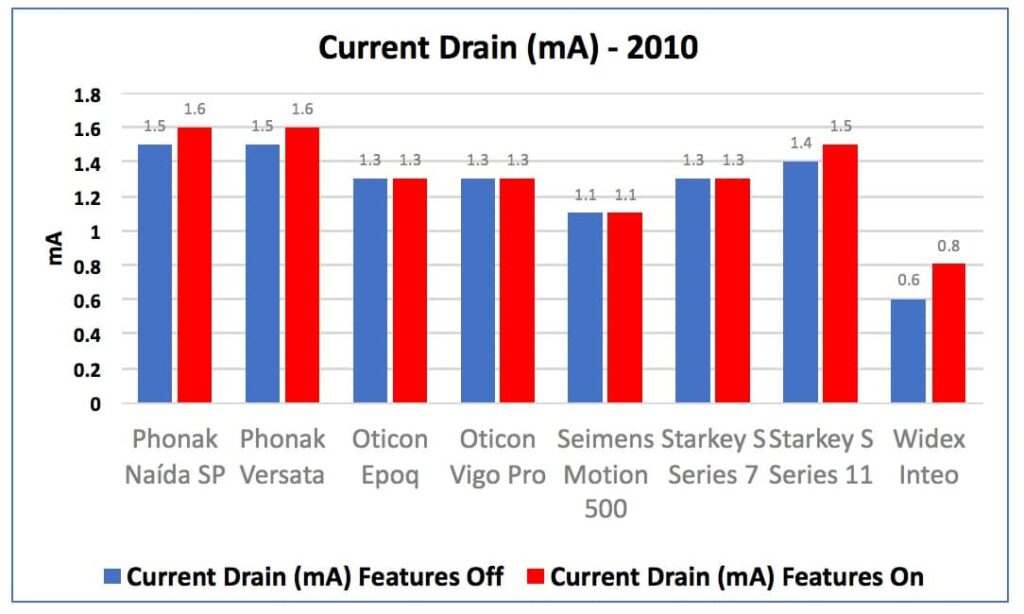
Figure 1. Current drain in mA for hearing aids measured in 2010, showing the drain of the instruments with their advanced fearures turned “Off” in blue, and then with the features turned “On” in red.
The following graphs, Figures 2 through 6, provide comparisons for the years 2011 through 2015. Notice that in these graphs, almost without failure, the current drain is higher with the features activated (On), than when deactivated (Off). It is suggested that this represents improved signal processing capabilities requiring the increased current drain.
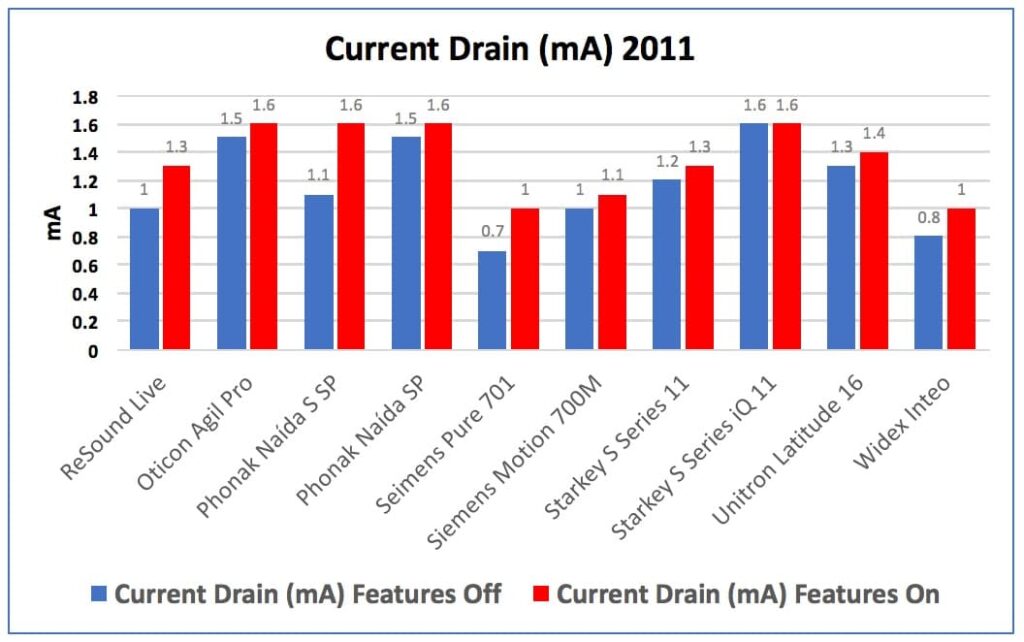
Figure 2. Current drain in mA for hearing aids measured in 2011, showing the drain of the instruments with their advanced fearures turned “Off” in blue, and then with the features turned “On” in red.
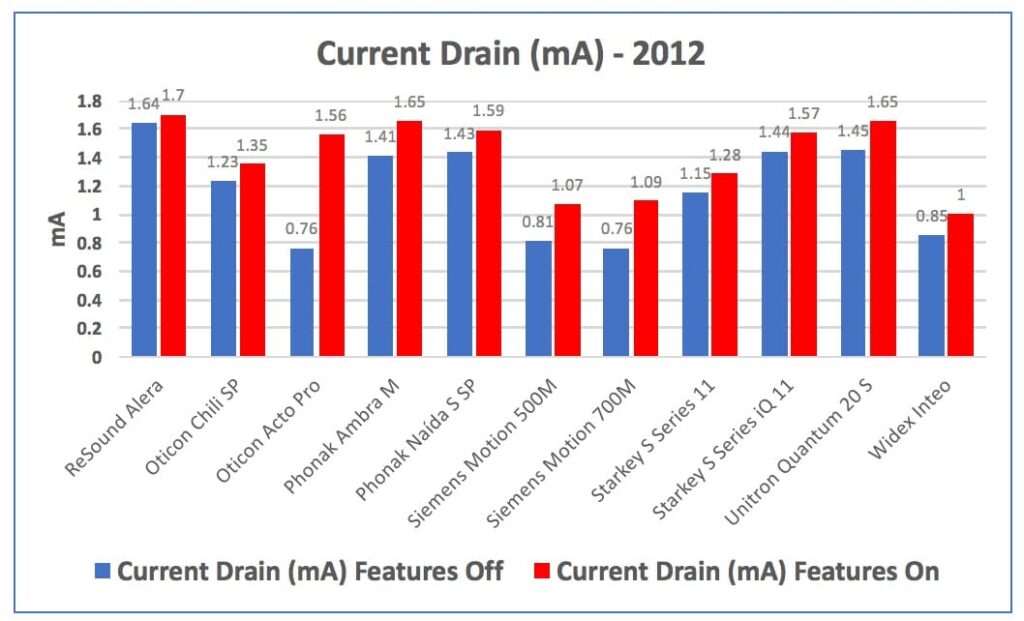
Figure 3. Current drain in mA for hearing aids measured in 2012, showing the drain of the instruments with their advanced fearures turned “Off” in blue, and then with the features turned “On” in red.
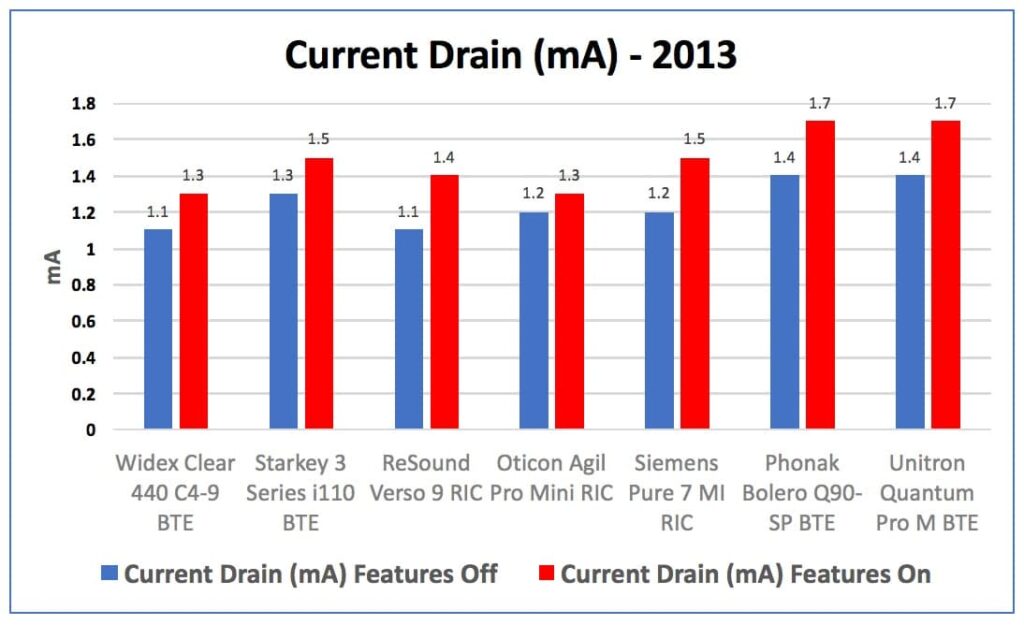
Figure 4. Current drain in mA for hearing aids measured in 2013, showing the drain of the instruments with their advanced fearures turned “Off” in blue, and then with the features turned “On” in red.
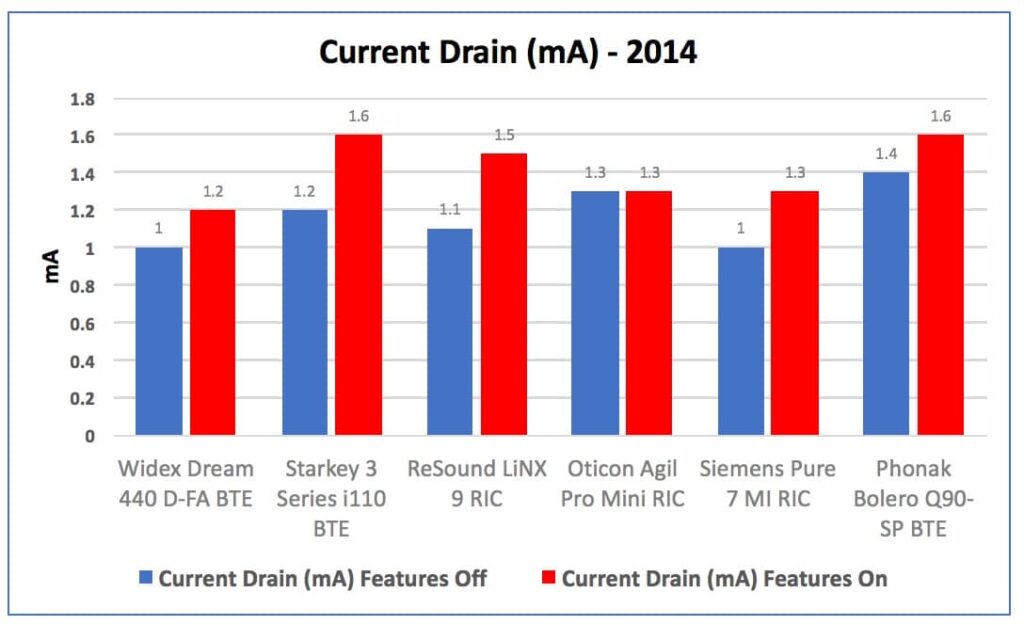
Figure 5. Current drain in mA for hearing aids measured in 2014, showing the drain of the instruments with their advanced fearures turned “Off” in blue, and then with the features turned “On” in red.
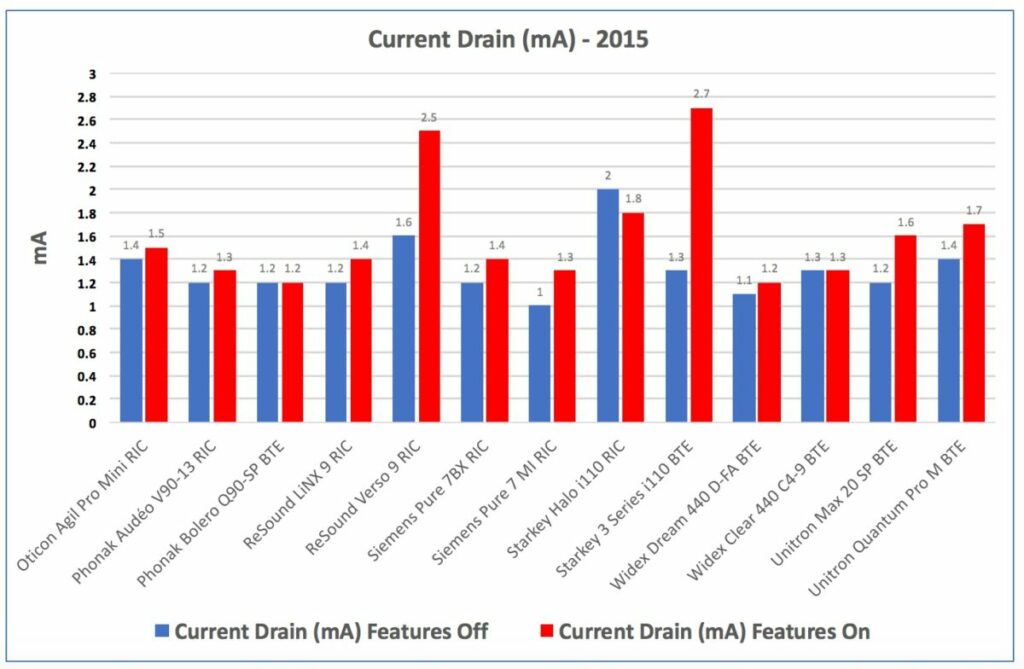
Figure 6. Current drain in mA for hearing aids measured in 2015, showing the drain of the instruments with their advanced fearures turned “Off” in blue, and then with the features turned “On” in red.
Battery Current Drain by Year
Hearing aid battery current drain (in mA) averaged by year is shown in Figure 7, along with a linear forecast out for an additional 2 years (years are not shown, but the dotted line extensions represent those years). The current drain with the features turned “Off” shows a slight upward trend, but that when the features are activated (On), there is an even greater increase in current drain with each subsequent year. This difference is 0.6 in 2010 to 0.29 mA in 2015. Undoubtedly, this reflects algorithms asking the hearing aid to expand its performance capabilities.
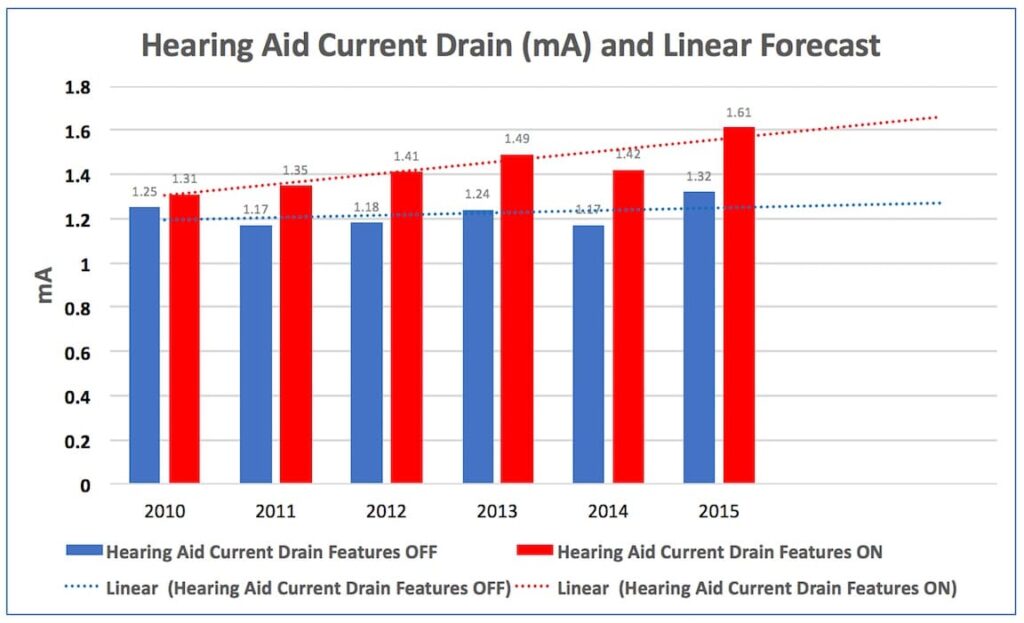
Figure 7. Hearing aid current drain and linear forecast for features “Off” and “On” (dotted lines) averaged from Figures 2 through 6. There is a trend of increased current drain with each subsequent year under both the features “Off” and “On,” but with a greater increase by year for the features “On” condition, suggesting that continued advanced signal processing algorithms demand higher current drain. Note: linear does NOT refer to linear amplification, but to the linear trend and forecast line for hearing aid feature conditions “Off” and “On.”
Current Drain (mA) Summary
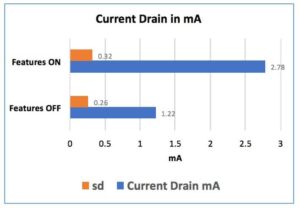
Figure 8. Combined current drain comparisons for the years 2010 through 2015 for the “Features Off” versus the “Features On,” showing an overall increase of 1.56 mA.
Combining all the data allows for an overall comparison to be made of the current drain in mA covering the years of these studies (2010 through 2015). Even ignoring the trend by year, the current drain with advanced signal processing algorithms activated (On) shows an increase in current drain of 1.56 mA over the deactivated (Off) hearing aid function (Figure 8).
What Does All This Mean?
As the current drain increases (goes up) in mA, the expected life of the battery decreases (goes down, or gets shorter). Certainly, more advanced signal processing algorithms, becoming more evident in the latest hearing aids, are leading to increased current drain when these features are activated.
Next week’s post will make some comparisons of how this changes battery life for size 13, 312, and 10 hearing aid cells/batteries.
Reference
Alexander, J. (2016). Personal communication. Purdue University.



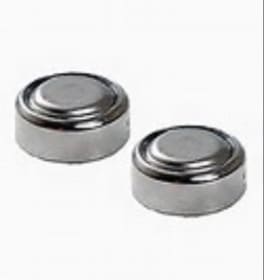




Hi
thank for this article, it is the best information about battery for me to choice one.
Then, i found a site same: “http://www.batteryreviews.net/
this is the same of your actile